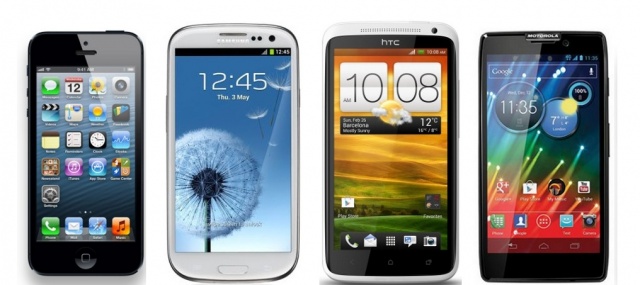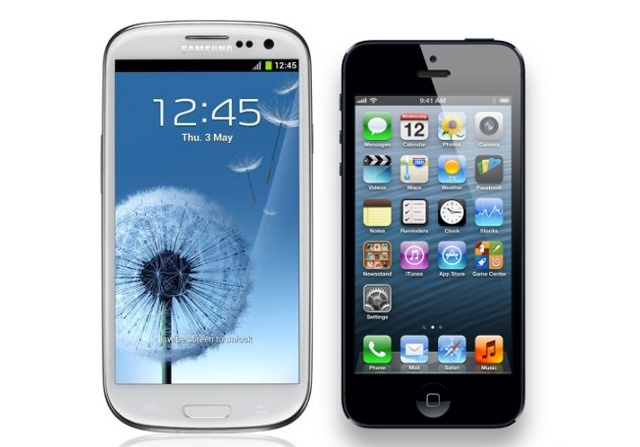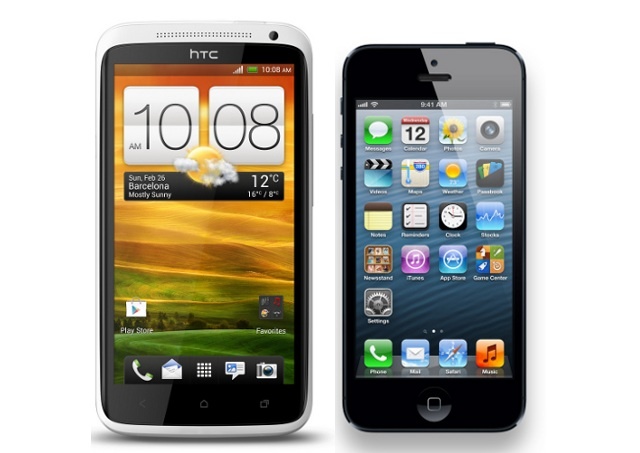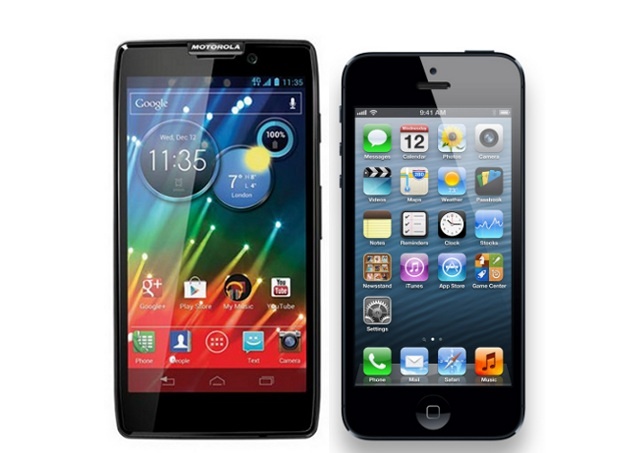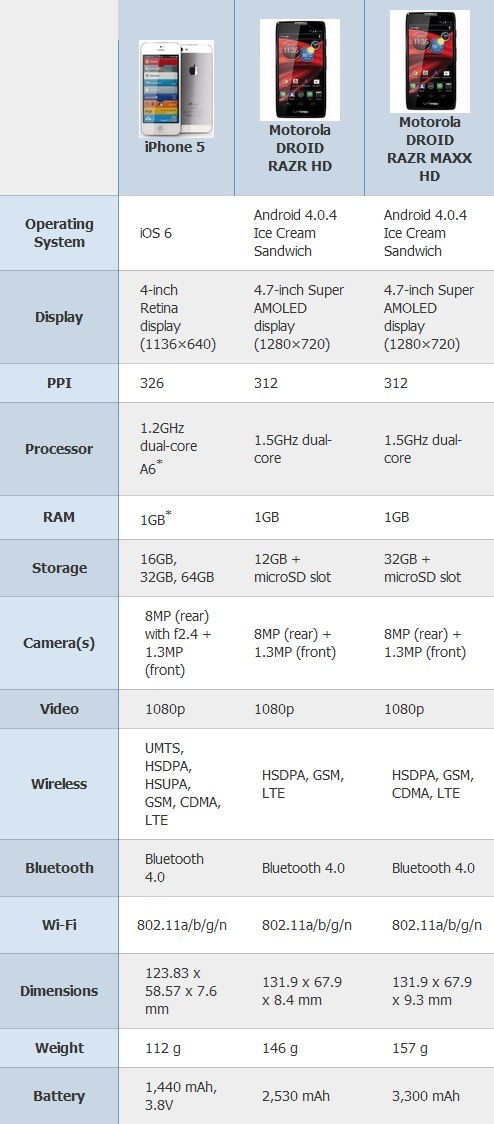If you are one of the many who were holding off on buying a new smartphone until after Apple unveiled the iPhone 5, it’s now time to make a decision. You’ve seen what the iPhone 5 has to offer and now it’s time to compare it to what’s available on Android. I’ll show you a few options, how they compare to the iPhone 5, and then you can decide what’s the best option for you. Ready to explore?
Samsung Galaxy S III
The first phone to take a look at is the Samsung Galaxy S III, which is considered to be one of the best Android devices available. It has everything you could want out of a smartphone and more. It’s larger than the iPhone 5 yet only minutely heavier. It has a beautiful 4.8-inch Super AMOLED display with only a slightly lower ppi than the iPhone 5.
Despite its size, I found it to fit perfectly in the hand thanks to a masterful design. I even found it more comfortable than most devices I’ve used. It’s wicked fast thanks to a 1.5 GHz dual-core processor and processes are smooth as butter thanks to its 2GB of RAM (US).
One big advantage the Galaxy S III has over the iPhone 5 is expandable memory. This means you can buy the cheapest storage model available now, and if you need more memory later on, you can simply pop in a microSD and expand it up to 64GB. That may seem like overkill to most of us, but you’d be surprised at how many people could fill that up.
Another advantage the Galaxy S III has is a removable battery. LTE is a battery hungry beast and while the Galaxy S III already has a larger battery than the iPhone 5, having the ability to pop in a freshly charged battery at a moments notice is as good as it gets for a power user in the heat of battle.
Both devices have 8MP rear cameras and both offer their own suites of camera software. I’m not a photo geek so I won’t pretend to be, but if it matters to you, the iPhone 5 sports an f.24 versus the Galaxy S III’s f2.6. As for front facing cameras, the Galaxy S III has a slightly larger MP than the iPhone 5 and both can record up to 720p.
As with any Apple device, you’ll pretty much be tied to their ecosystem, while with the Samsung Galaxy S III you have tons of options for your content. You’ll also have more flexibility with video out thanks to DLNA and HDMI (through MHL) support.
Other features you’ll get on the Galaxy S III that you won’t find on the iPhone 5 include: NFC, wireless charging, a barometer, and various Samsung software features such as pop-up play as well as all of the features in Android 4.0.4 (Ice Cream Sandwich).
Now for the best part: every major carrier offers the Samsung Galaxy S III and if you head over to Amazon Wireless, prices start as low at $119.99! That’s almost $80 cheaper than what you’ll pay for the 16GB model of the iPhone 5.
AT&T | Sprint | T-Mobile | Verizon
HTC One X
The HTC One X is a formidable competitor that is unfortunately overshadowed in the Android world by the Samsung Galaxy S III. It’s a solid made device that features a brilliant 4.7-inch Super LCD2 with 312ppi. That’s still a slightly lower ppi than the iPhone 5 but you’re also getting a .7-inch larger display.
The HTC One X is also a fast phone thanks to a 1.5GHz dual-core processor (U.S. variant) and shares the same amount of RAM as the iPhone 5. Both the iPhone 5 and HTC One X have non-removable batteries, however, the One X has a larger 1800mAh battery which you’ll want with LTE.
One disadvantage of the HTC One X is its lack of expandable storage and the fact that it only comes in a 16GB model here in the U.S. It’s also only available on AT&T so you don’t have much of a carrier choice as you do with the iPhone 5 and the Samsung Galaxy S III.
Again, both devices have an 8MP rear camera and both offer their own suites of camera software.The HTC One X has a f2 aperture and a front facing camera with a slightly higher MP.
The HTC One X has all the features of Android 4.0.4 (Ice Cream Sandwich) as well as HTC’s own Sense 4.1 software (which I personally don’t care for). With the One X you also get the extra video-out flexibility of DLNA, MediaLink HD, and HDMI (through MHL) support.
The HTC One X is certainly a decent option, and with prices starting at $89.99 it deserves a look.
One other thing of note: Sprint offers the HTC Evo 4G LTE which is a variation of the One X with similar specs and the advantage of expandable memory, albeit a higher price tag ($129.99).
Motorola DROID RAZR MAXX HD
The Motorola DROID RAZR Maxx HD isn’t available just yet, but it should hit shelves soon. As with all the other Android competitors, it features a larger display and less ppi than the iPhone 5. The DROID RAZR MAXX HD has a 4.7-inch AMOLED display with a ppi of 312 versus the iPhone’s 4-inch IPS LCD with 326ppi.
The DROID RAZR line has a unique design that you either love or hate (I’m a fan of the latter). It’s solid hardware but much larger and heavier than the iPhone 5.
There’s no lack of speed with its 1.5GHz dual-core processor, and like the One X, it shares the same amount of RAM as the iPhone 5. One thing the RAZR MAXX HD doesn’t share is its incredible battery. Sporting a 3300mAh battery (more than double that of the iPhone 5), the DROID RAZR MAXX HD boasts 21 hours of talk time, 10 hours of video streaming, 13 hours of video playback, and 27 hours of music playback on a single charge — all while connected to Verizon’s 4G LTE network.
The DROID RAZR MAXX HD also has the advantage of expandable memory should you need it. It comes standard with 32GB but can be expanded by another 32GB with a microSD card.
As for the camera, the MAXX HD and the iPhone 5 both have an 8MP rear facing camera with a f2.4 aperture, however, the iPhone 5 has a back-illuminated sensor which the MAXX HD does not. As for the front-facing camera, the MAXX HD has a minutely larger MP at 1.3 versus 1.2 — both of which record up to 720p.
The RAZR MAXX is set to launch with the latest version of Android (Jelly Bean) as well as Motorola’s own software. One drawback will probably come in the form of bloatware. You can guarantee Verizon is going to load up the MAXX HD with tons of crap you don’t want. However, Motorola will be offering a “Developer Edition” which you’ll be able to unlock and hack to your hearts content.
On top of all the software features, you get the usual extra video-out flexibility of standards such as DLNA and HDMI.
The DROID RAZR MAXX HD is set to cost around $299, a price which is the same as the 32GB iPhone 5.
Note: If the MAXX HD is a bit much for you, there’s also the RAZR HD. The RAZR HD is the same as the MAXX HD, only it comes with 16GB of storage versus 32 and a 2,530mAh battery instead of the 3300. The RAZR HD will also cost less, most likely around $199.
TBA
Conclusion
Those are just a few options when comparing the iPhone 5 to current Android devices. If you’re looking for something else, fear not, Android has an abundance of choices. There’s something for everyone: large screens, small screens; $300 devices, free devices; physical keyboard, touch keyboard; I’m talking everything.
As far as getting the best for your money, I’m a major fan of the Samsung Galaxy S III. It has tons of top-tier hardware and software, a sub $200 price, and comes with the freedom of carrier choice. If you’d like a better look at the Samsung Galaxy S III, you can always take a look at our review.
Happy hunting!
